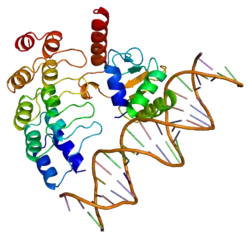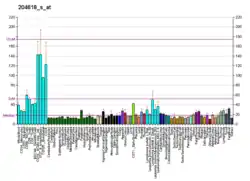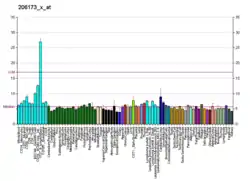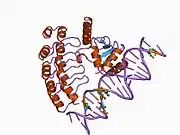GABPB2
GA-binding protein subunit beta-1 is a protein that in humans is encoded by the GABPB1 gene.[5][6]
This gene encodes the GA-binding protein transcription factor, beta subunit. This protein forms a tetrameric complex with the alpha subunit, and stimulates transcription of target genes. The encoded protein may be involved in activation of cytochrome oxidase expression and nuclear control of mitochondrial function. The crystal structure of a similar protein in mouse has been resolved as a ternary protein complex. Multiple transcript variants encoding distinct isoforms have been identified for this gene.[6]
References
- GRCh38: Ensembl release 89: ENSG00000104064 - Ensembl, May 2017
- GRCm38: Ensembl release 89: ENSMUSG00000027361 - Ensembl, May 2017
- "Human PubMed Reference:". National Center for Biotechnology Information, U.S. National Library of Medicine.
- "Mouse PubMed Reference:". National Center for Biotechnology Information, U.S. National Library of Medicine.
- de la Brousse FC, Birkenmeier EH, King DS, Rowe LB, McKnight SL (Nov 1994). "Molecular and genetic characterization of GABP beta". Genes Dev. 8 (15): 1853–65. doi:10.1101/gad.8.15.1853. PMID 7958862.
- "Entrez Gene: GABPB2 GA binding protein transcription factor, beta subunit 2".
Further reading
- Sawada J, Goto M, Watanabe H, et al. (1995). "Regional mapping of two subunits of transcription factor E4TF1 to human chromosome". Jpn. J. Cancer Res. 86 (1): 10–2. doi:10.1111/j.1349-7006.1995.tb02981.x. PMC 5920589. PMID 7737900.
- Gugneja S, Virbasius JV, Scarpulla RC (1995). "Four structurally distinct, non-DNA-binding subunits of human nuclear respiratory factor 2 share a conserved transcriptional activation domain". Mol. Cell. Biol. 15 (1): 102–11. doi:10.1128/MCB.15.1.102. PMC 231915. PMID 7799916.
- Virbasius JV, Virbasius CA, Scarpulla RC (1993). "Identity of GABP with NRF-2, a multisubunit activator of cytochrome oxidase expression, reveals a cellular role for an ETS domain activator of viral promoters". Genes Dev. 7 (3): 380–92. doi:10.1101/gad.7.3.380. PMID 8383622.
- Watanabe H, Sawada J, Yano K, et al. (1993). "cDNA cloning of transcription factor E4TF1 subunits with Ets and notch motifs". Mol. Cell. Biol. 13 (3): 1385–91. doi:10.1128/MCB.13.3.1385. PMC 359448. PMID 8441384.
- Gugneja S, Virbasius CM, Scarpulla RC (1996). "Nuclear respiratory factors 1 and 2 utilize similar glutamine-containing clusters of hydrophobic residues to activate transcription". Mol. Cell. Biol. 16 (10): 5708–16. doi:10.1128/mcb.16.10.5708. PMC 231571. PMID 8816484.
- Sawa C, Goto M, Suzuki F, et al. (1997). "Functional domains of transcription factor hGABP beta1/E4TF1-53 required for nuclear localization and transcription activation". Nucleic Acids Res. 24 (24): 4954–61. doi:10.1093/nar/24.24.4954. PMC 146336. PMID 9016666.
- Sowa Y, Shiio Y, Fujita T, et al. (1997). "Retinoblastoma binding factor 1 site in the core promoter region of the human RB gene is activated by hGABP/E4TF1". Cancer Res. 57 (15): 3145–8. PMID 9242441.
- Batchelor AH, Piper DE, de la Brousse FC, et al. (1998). "The structure of GABPalpha/beta: an ETS domain- ankyrin repeat heterodimer bound to DNA". Science. 279 (5353): 1037–41. Bibcode:1998Sci...279.1037B. doi:10.1126/science.279.5353.1037. PMID 9461436.
- Suzuki F, Goto M, Sawa C, et al. (1998). "Functional interactions of transcription factor human GA-binding protein subunits". J. Biol. Chem. 273 (45): 29302–8. doi:10.1074/jbc.273.45.29302. PMID 9792629.
- Sawada J, Simizu N, Suzuki F, et al. (2000). "Synergistic transcriptional activation by hGABP and select members of the activation transcription factor/cAMP response element-binding protein family". J. Biol. Chem. 274 (50): 35475–82. doi:10.1074/jbc.274.50.35475. PMID 10585419.
- Vogel JL, Kristie TM (2000). "The novel coactivator C1 (HCF) coordinates multiprotein enhancer formation and mediates transcription activation by GABP". EMBO J. 19 (4): 683–90. doi:10.1093/emboj/19.4.683. PMC 305606. PMID 10675337.
- Sawa C, Yoshikawa T, Matsuda-Suzuki F, et al. (2002). "YEAF1/RYBP and YAF-2 are functionally distinct members of a cofactor family for the YY1 and E4TF1/hGABP transcription factors". J. Biol. Chem. 277 (25): 22484–90. doi:10.1074/jbc.M203060200. PMID 11953439.
- Marie S, Race V, Nassogne MC, et al. (2002). "Mutation of a nuclear respiratory factor 2 binding site in the 5' untranslated region of the ADSL gene in three patients with adenylosuccinate lyase deficiency". Am. J. Hum. Genet. 71 (1): 14–21. doi:10.1086/341036. PMC 384970. PMID 12016589.
- Strausberg RL, Feingold EA, Grouse LH, et al. (2003). "Generation and initial analysis of more than 15,000 full-length human and mouse cDNA sequences". Proc. Natl. Acad. Sci. U.S.A. 99 (26): 16899–903. doi:10.1073/pnas.242603899. PMC 139241. PMID 12477932.
- Rual JF, Venkatesan K, Hao T, et al. (2005). "Towards a proteome-scale map of the human protein-protein interaction network". Nature. 437 (7062): 1173–8. Bibcode:2005Natur.437.1173R. doi:10.1038/nature04209. PMID 16189514. S2CID 4427026.
- Jeong BC, Kim MY, Lee JH, et al. (2006). "Brain-specific angiogenesis inhibitor 2 regulates VEGF through GABP that acts as a transcriptional repressor". FEBS Lett. 580 (2): 669–76. doi:10.1016/j.febslet.2005.12.086. PMID 16412436. S2CID 35468847.
- Lim J, Hao T, Shaw C, et al. (2006). "A protein-protein interaction network for human inherited ataxias and disorders of Purkinje cell degeneration". Cell. 125 (4): 801–14. doi:10.1016/j.cell.2006.03.032. PMID 16713569. S2CID 13709685.
External links
- GABPB2+protein,+human at the US National Library of Medicine Medical Subject Headings (MeSH)
- Overview of all the structural information available in the PDB for UniProt: Q00420 (Mouse GA-binding protein subunit beta-1) at the PDBe-KB.
This article incorporates text from the United States National Library of Medicine, which is in the public domain.
This article is issued from Wikipedia. The text is licensed under Creative Commons - Attribution - Sharealike. Additional terms may apply for the media files.







